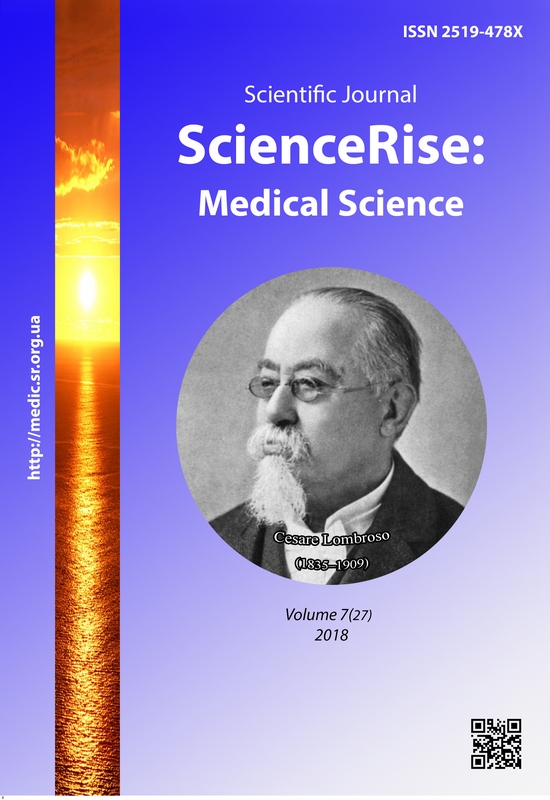Analysis of post operation period after primary hip arthroplasty in proximal femoral fracture depending on postsurgery wound drainage
DOI:
https://doi.org/10.15587/2519-4798.2018.149293Keywords:
proximal femoral fracture, primary hip replacement, drainage, blood loss, hemoconcentrationAbstract
Drainage of postoperative wounds for a long time remained the obligatory stage of operative intervention at arthroplasty of a hip joint. But recently in many clinics there are a tendency for a total refusal from this stage. The results of the research highlight only the positive features of these changes, but our experience has shown both an improvement and a decrease in the outcome of treatment.
The aim of the research is to establish the expediency of refusing to drain postoperative wounds after hip replacement with fractures of the proximal thigh.
Material and methods. The analysis of 44 patients with fractures of the proximal thigh after the initial replacement with unipolar prothesis with a dual movement head was performed. Representative groups have been formed depending on the use of post-operative wound layer drainage. In the postoperative period, an assessment of pain syndrome for VAS was used. We applied a visual assessment of health (EQ VAS) and questionnaires EQ-5D-5L. Hidden blood loss = BCC x (hematocrit before - hematocrit after), where hematocrit before is the value of the indicator for the operation, hematocrit after - the value of the index for 7 days after the operation. The determination of the volume of circulating blood (BCC) was carried out using the formula by Nadler, Hidalgo and Bloch: PBV=K1×height (m)3+K2×weight (kg)+K3, where K1=0.3669, K2=0.03219, K3=0.6041 for men; K1=0.3561, K2=0.03308, K3=0.1833 for women.
Results. The intensification of pain syndrome was detected up to 3 days after the postoperative term in the case of failure of layer drainage. There was no statistically significant difference in the indicators of the quality of life assessment, but the patient's ability to raise the straightened limb with refusal of drainage was observed more often than 2 days compared with 4 days in patients who performed layered drainage of postoperative wound. Significantly improved hemodynamic rates to 7 days of the postoperative period and consequently reduced blood loss. Twice times more often, hyperemia of the postoperative wound was observed in the event of withdrawal from drainage. Increase the length of the hip circumference and regress to 7 days. According to the assessment of the questionnaire EQ-5D-5L, there was no statistically significant difference in the assessment of the quality of life of the affected, depending on drainage.
Conclusions. Denial from drainage improves hemodynamic rates in the postoperative period in the study group, slightly increasing the pain syndrome from the first to the third day. Refusal from the layered drainage of the postoperative wound with the fractures of the proximal thigh section in the primary arthroplasty is reasonable
References
- Poluliakh, M. V., Herasymenko, S. I., Sulyma, V. S., Yuriichuk, L. M. (2008). Pervynne endoprotezuvannia pry cherez- ta mizhvertelnykh perelomakh stehnovoi kistky u khvorykh pokhyloho ta starechoho viku. Travma, 9 (4). Available at: http://www.mif-ua.com/archive/article/20425
- Haiko, H. V., Kukurudza, L. P., Torchynskyi, V. P., Pidhaietskyi, V. M., Sulyma, O. M., Osadchuk, T. I. (2003). Endoprotezuvannia kulshovoho suhloba u khvorykh pokhyloho viku pry perelomakh proksymalnoho viddilu stehnovoi kistky. Totalne i reviziine endoprotezuvannia velykykh suhlobivz. Kyiv-Lviv, 11–15.
- Berend, K. R., Hanna, J., Smith, T. M., Mallory, T. H., Lombardi, A. V. (2005). Acute hip arthroplasty for the treatment of intertrochanteric fractures in the elderly. Journal of Surgical Orthopaedic Advances, 14 (4), 185–189.
- Parvizi, J., Porat, M. (2011). Draining wounds: No time to procrastinate. Orthopedics Today. Available at: https://www.healio.com/orthopedics/hip/news/print/orthopedics-today/ %7Ba52f5269-d323-4cde-8340-32d2b4181f15 %7D/draining-wounds-no-time-to-procrastinate
- EQ-5D-5L | About. Available at: https://euroqol.org/eq-5d-instruments/eq-5d-5l-about/
- Tikhilov, R. M., Shubnyakov, I. I., Myasoedov, A. A., Pliev, D. G., Karelkin, V. V., Berezin, G. V. (2018). Total hip in case of hip bone ankylosis different etiology, reasons and result. Modern Problems of Science and Education, 2. doi: http://doi.org/10.17513/spno.27426
- Whynes, D. K. (2008). Correspondence between EQ-5D health state classifications and EQ VAS scores. Health and Quality of Life Outcomes, 6 (1), 94. doi: http://doi.org/10.1186/1477-7525-6-94
- EQ-5D-5L User Guide Basic information on how to use the EQ-5D-5L instrument (2015). Available at: https://euroqol.org/wp-content/uploads/2016/09/EQ-5D-5L_UserGuide_2015.pdf
- Nadler, S. B., Hidalgo, J. U., Bloch, T. (1962). Prediction of blood volume in normal human adults. Surgery, 51, 224–232.
- Bourke, D. L., Smith, T. C. (1974). Estimating Allowable Hemodilution. Anesthesiology, 41 (6), 609–611. doi: http://doi.org/10.1097/00000542-197412000-00015
- Khadzkou, Y. K., Balaboshka, K. B. (2017). The role of vacuum drainage in total knee replacement. Vestnik of Vitebsk State Medical University, 16 (4), 73–80. doi: http://doi.org/10.22263/2312-4156.2017.4.73
Downloads
Published
How to Cite
Issue
Section
License
Copyright (c) 2018 Volodymyr Babalian

This work is licensed under a Creative Commons Attribution 4.0 International License.
Our journal abides by the Creative Commons CC BY copyright rights and permissions for open access journals.
Authors, who are published in this journal, agree to the following conditions:
1. The authors reserve the right to authorship of the work and pass the first publication right of this work to the journal under the terms of a Creative Commons CC BY, which allows others to freely distribute the published research with the obligatory reference to the authors of the original work and the first publication of the work in this journal.
2. The authors have the right to conclude separate supplement agreements that relate to non-exclusive work distribution in the form in which it has been published by the journal (for example, to upload the work to the online storage of the journal or publish it as part of a monograph), provided that the reference to the first publication of the work in this journal is included.









